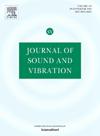Solving 2-D Helmholtz equation in the rectangular, circular, and elliptical domains using neural networks
IF 4.3
2区 工程技术
Q1 ACOUSTICS
引用次数: 0
Abstract
Physics-informed neural networks offered an alternate way to solve several differential equations that govern complicated physics. However, their success in predicting the acoustic field is limited by the vanishing-gradient problem that occurs when solving the Helmholtz equation. In this paper, a formulation is presented that addresses this difficulty. The problem of solving the two-dimensional Helmholtz equation with the prescribed boundary conditions is posed as an unconstrained optimization problem using trial solution method. According to this method, a trial neural network that satisfies the given boundary conditions prior to the training process is constructed using the technique of transfinite interpolation and the theory of R-functions. This ansatz is initially applied to the rectangular domain and later extended to the circular and elliptical domains. The acoustic field predicted from the proposed formulation is compared with that obtained from the two-dimensional finite element methods. Good agreement is observed in all three domains considered. Minor limitations associated with the proposed formulation and their remedies are also discussed.
求助全文
约1分钟内获得全文
求助全文
来源期刊

Journal of Sound and Vibration
工程技术-工程:机械
CiteScore
9.10
自引率
10.60%
发文量
551
审稿时长
69 days
期刊介绍:
The Journal of Sound and Vibration (JSV) is an independent journal devoted to the prompt publication of original papers, both theoretical and experimental, that provide new information on any aspect of sound or vibration. There is an emphasis on fundamental work that has potential for practical application.
JSV was founded and operates on the premise that the subject of sound and vibration requires a journal that publishes papers of a high technical standard across the various subdisciplines, thus facilitating awareness of techniques and discoveries in one area that may be applicable in others.
 求助内容:
求助内容: 应助结果提醒方式:
应助结果提醒方式:


